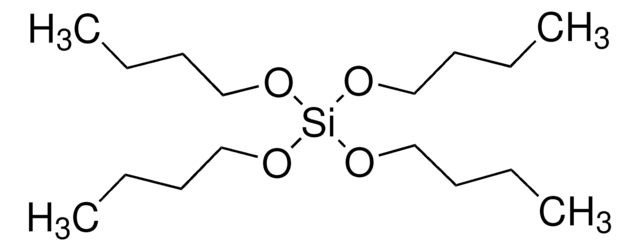218472
Tetramethyl orthosilicate
98%
Sinónimos:
Tetramethoxysilane
About This Item
Productos recomendados
densidad de vapor
5.25 (vs air)
Nivel de calidad
presión de vapor
13 hPa ( 20 °C)
Análisis
98%
formulario
liquid
índice de refracción
n20/D 1.368 (lit.)
bp
121-122 °C (lit.)
mp
−4 °C (lit.)
densidad
1.023 g/mL at 25 °C (lit.)
cadena SMILES
CO[Si](OC)(OC)OC
InChI
1S/C4H12O4Si/c1-5-9(6-2,7-3)8-4/h1-4H3
Clave InChI
LFQCEHFDDXELDD-UHFFFAOYSA-N
¿Está buscando productos similares? Visita Guía de comparación de productos
Aplicación
Palabra de señalización
Danger
Frases de peligro
Consejos de prudencia
Clasificaciones de peligro
Acute Tox. 1 Inhalation - Eye Dam. 1 - Flam. Liq. 3 - Skin Irrit. 2
Código de clase de almacenamiento
3 - Flammable liquids
Clase de riesgo para el agua (WGK)
WGK 1
Punto de inflamabilidad (°F)
78.8 °F - closed cup
Punto de inflamabilidad (°C)
26 °C - closed cup
Equipo de protección personal
Eyeshields, Faceshields, Gloves, type ABEK (EN14387) respirator filter
Elija entre una de las versiones más recientes:
¿Ya tiene este producto?
Encuentre la documentación para los productos que ha comprado recientemente en la Biblioteca de documentos.
Los clientes también vieron
Artículos
Silica is a very popular inorganic nanomaterial used in a wide range of applications including fillers for rubber, catalyst supports, separation media, carriers in food and agriculture, and abrasive/anticaking agents in cosmetics. It is also widely believed to be an important material for biomedical applications for following reasons.
Magnetism and magnetic materials have been of scientific interest for over 1,000 years. More recently, fundamental investigations have focused on exploring the various types of magnetic materials and understanding the magnetic effects created by electric currents.
Hybrid organic-inorganic sol-gel materials containing silica were first called “ORMOSILs” in 1984.
The properties of many devices are limited by the intrinsic properties of the materials that compose them.
Nuestro equipo de científicos tiene experiencia en todas las áreas de investigación: Ciencias de la vida, Ciencia de los materiales, Síntesis química, Cromatografía, Analítica y muchas otras.
Póngase en contacto con el Servicio técnico












